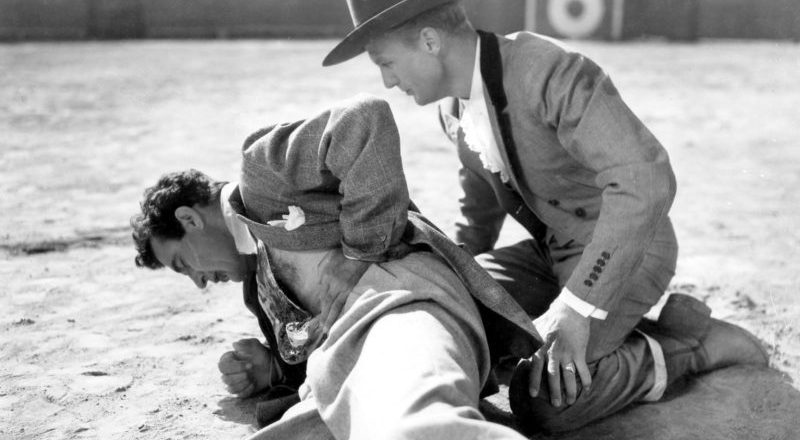INTERVIEW: ‘Bullfighter and the Lady’ revisited in Film Forum event
Photo: Bullfighter and the Lady is the first “A” movie from director Budd Boetticher. Photo courtesy of Film Forum / Provided with permission.
Budd Boetticher’s 1951 film Bullfighter and the Lady was originally cut by more than half an hour for American audiences, and one theory is that the excision happened because of its subtle gay undercurrents. Now audiences will be able to watch the director’s original version, running more than two hours, at New York City’s Film Forum.
The special one-time-only screening will feature an introduction by film scholar Luis Reyes, author of Made in Mexico: Hollywood South of the Border. He will sign copies of the book in the lobby following the 4:45 p.m. screening Saturday, June 15.
“It’s a wonderful movie,” Reyes said in a recent phone interview. “It’s very well done historically. It has its origins in the life of Bud Boetticher. Budd Boetticher is perhaps best known today for the series of westerns that he did with Randolph Scott at the end of the ’50s — Comanche Station, 7 Men From Now — very lean, taut westerns that feature Randolph Scott and then some up-and-coming actors like James Coburn, people like that.”
The inspiration for Bullfighter and the Lady, which stars Robert Stack, Joy Page, Virginia Grey and Gilbert Roland, came from the director’s visit to Mexico after college because he had come down with an illness. He traveled to the country to recover, and he fell in love with Mexico, its culture and the art of bullfighting.
“He became quite an accomplished bullfighter,” Reyes said. “What happens is he came to Los Angeles, and consequently enough they were doing a remake of the [Rudolph] Valentino film, Blood and Sand, from 1927. And the remake starred Tyrone Power, and they needed somebody to teach Tyrone Power how to move like a bullfighter because most of the film was shot in Los Angeles. … Budd Boetticher helped Tyrone Power. He became a consultant for the film on bullfighting, and that was like his [introduction] into Hollywood. And he worked his way up the ladder in Hollywood to becoming an assistant director, to becoming a director, and the Bullfighter and the Lady was his first major ‘A’ film. And it was done for Republic Studios and for director-producer-actor John Wayne.”
The controversy involving the gay themes in the movie didn’t grab headlines at the time because the studio didn’t publicly acknowledge that the director’s version was cut by approximately 40 minutes. Audience members at the Film Forum will have the chance to watch the original, longer version, restored by the UCLA Film & Television Archive. Viewers will likely pick up on the subtle relationship between Stack and Roland’s characters.
“There were many inferences there,” Reyes said. “Actually in the first frame of the movie, when it opens up, when you have all the matadors lined up, it’s funny in how they all kind of line up behind a sign that says ‘gay.’ There are these undercurrents that verge on certain gay themes, but basically the movie really centers on the relationship between the young matador and the older matador.”
He added: “The cut that was released in the United States was only 87 minutes, so they cut about a half hour of the movie. And a lot of it centered on the relationship between Manolo and Johnny Regan, which was Robert Stack and Gilbert Roland, but what happened was when they released it in Latin America, they released it in its complete cut. And that’s the way they were able to restore the longer original version because the elements were still in Latin America for the original version, the two-hour version.”
According to an essay on TCM.com, there were also calls to edit the film so it could be short enough to fit on a double bill in the movie theater.
Mexico in the 1950s was a favorite shooting location for many Hollywood films, in particular westerns. Before World War II, few productions headed to the country, but after the global conflict, the two countries worked closely with each other.
“[Before the war], they had huge studios on the Hollywood backlot, so they tried to keep everything here,” he said. “So for a movie like Juarez with Paul Muni, they had built a whole Mexican village on the backlot, so they tried to keep everything here at the studios here in Los Angeles.”
After World War II, with the advent of lighter equipment and the easier ability to use planes and trains helped studios film in Mexico. Also, there was the lower labor costs and the burgeoning Mexican film industry, which at times rivaled Hollywood’s productions.
“Then you start talking about the rise of television, and in order to compete with television, Hollywood wanted to go to actual locations, give them real backdrops,” Reyes said. “Then you had Cinemascope and the widescreen, so you wanted backdrops that were never seen before in Technicolor, Super Technirama, Cinemascope, all of that. So all of those things combined made Mexico a popular place to film.”
By John Soltes / Publisher / John@HollywoodSoapbox.com
Bullfighter and the Lady, directed by Budd Boetticher, will play Saturday, June 15 at 4:45 p.m. at New York City’s Film Forum. Luis Reyes will introduce the film and sign copies of his book, Made in Mexico: Hollywood South of the Border. Click here for more information and tickets.

